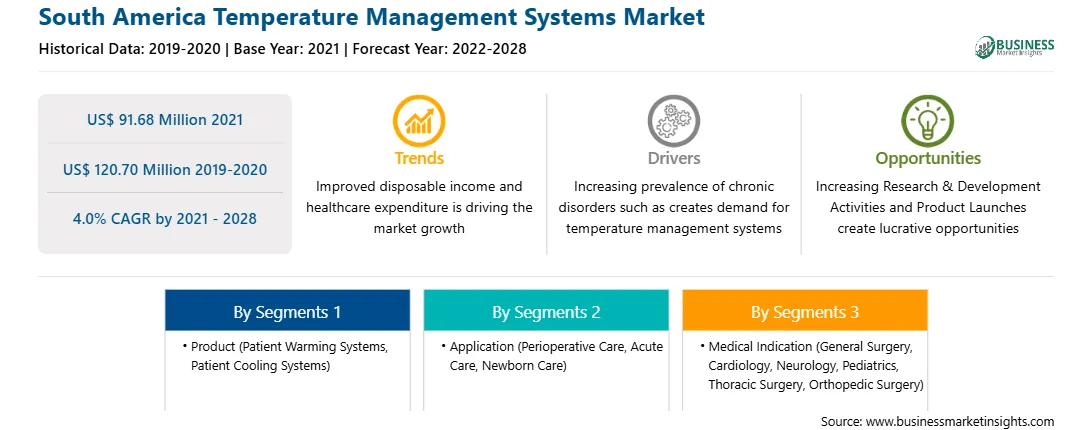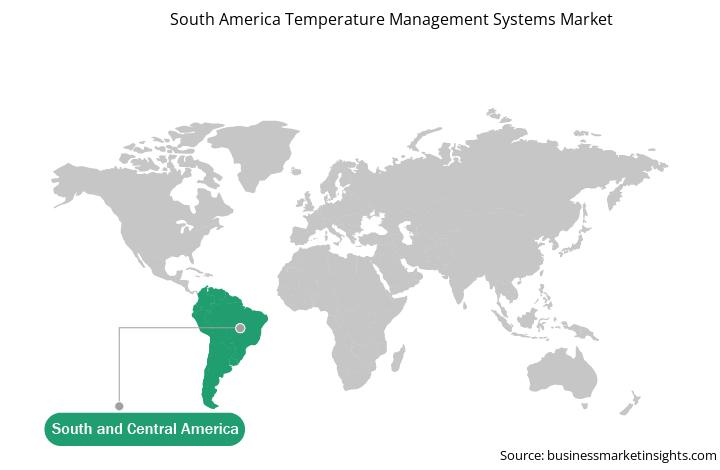南美洲温度管理系统市场预测至 2028 年 - COVID-19 影响和按产品(患者加温系统和患者冷却系统)、应用(围手术期护理、急性护理、新生儿护理等)和医疗适应症(一般)进行区域分析外科、心脏病学、神经内科、儿科、胸外科、骨科等)
No. of Pages: 139 | Report Code: TIPRE00023850 | Category: Life Sciences
No. of Pages: 139 | Report Code: TIPRE00023850 | Category: Life Sciences
南美洲地区包括巴西和 SAM 的其他地区。预计巴西将占据该地区的主要市场份额。此外,预计将以最高的增长率增长。巴西是世界上面积和人口第五大国,并且经历着全球最快的人口老龄化。在巴西,在区域和历史社会经济不平等的背景下,人口老龄化速度很快。根据在巴西进行的研究,妇女群体估计占绝大多数,老年人口数量为 1,690 万(56%),而老年人估计约有 1,690 万(56%)。 1330 万(44%)。人口老龄化的不断增长会导致多种慢性疾病,例如心血管疾病、骨科疾病、神经退行性疾病和糖尿病等。慢性病和心血管疾病患病率的上升是推动 SAM 温度管理系统市场增长的主要因素。
巴西等 SAM 国家已登记了许多冠状病毒感染阳性病例。该地区在医疗保健和医疗服务业方面正在发展。该地区国家高度依赖从发达国家进口的医疗器械。因此,由于供应链的严重中断,各国对温度管理系统的要求面临着多项挑战。卫生当局担心,抗击冠状病毒的尝试将间接导致患者死亡人数增加,包括心脏病患者、妇科患者和其他原因的患者。巴西、阿根廷、哥伦比亚等国受疫情影响严重。尽管如此,随着该地区各地的新冠病例减少,供应链到 2020 年底就恢复了。这些因素因此促进了 SAM 温度管理系统市场的增长。此外,政府对医疗设备的支持和报销政策的增加预计将支持温度管理系统市场。总体而言,COVID-19大流行减缓了增长速度,但并未完全对市场增长产生负面影响。
SAM 温度管理系统市场分为产品、应用、医疗适应症和国家/地区。根据产品,市场分为患者加温系统和患者冷却系统。患者加温系统领域在 2020 年占据市场主导地位,患者冷却系统领域预计将在预测期内增长最快。进一步的患者加温系统已分为表面加温系统、血管内加温系统和加温配件。同样,患者冷却系统分为表面冷却系统、血管内冷却系统和冷却配件。根据应用,市场分为围手术期护理、急性护理、新生儿护理等。围手术期护理领域在 2020 年占据市场主导地位,而急性护理领域预计将在预测期内增长最快。根据医疗适应症,市场分为普通外科、心脏病学、神经内科、儿科、胸外科、骨科等。普通外科领域在 2020 年占据市场主导地位,心脏病学领域预计将在预测期内增长最快。
准备本 SAM 温度管理系统市场报告时参考的一些主要一手和二手来源包括公司网站、年度报告、财务报告、国家政府文件和统计数据库等。报告中列出的主要公司有 3M、BD、Dragerwerk AG 和Co. KGaA、Ecolab、Inspiration Healthcare Group plc、Smiths Medical、Stryker Corporation 和 ZOLL MEDICAL CORPORATION 等。
Strategic insights for South America Temperature Management Systems involve closely monitoring industry trends, consumer behaviours, and competitor actions to identify opportunities for growth. By leveraging data analytics, businesses can anticipate market shifts and make informed decisions that align with evolving customer needs. Understanding these dynamics helps companies adjust their strategies proactively, enhance customer engagement, and strengthen their competitive edge. Building strong relationships with stakeholders and staying agile in response to changes ensures long-term success in any market.

| Report Attribute | Details |
|---|---|
| Market size in 2021 | US$ 91.68 Million |
| Market Size by 2028 | US$ 120.70 Million |
| Global CAGR (2021 - 2028) | 4.0% |
| Historical Data | 2019-2020 |
| Forecast period | 2022-2028 |
| Segments Covered |
By 产品
|
| Regions and Countries Covered | 南美洲和中美洲
|
| Market leaders and key company profiles |
The regional scope of South America Temperature Management Systems refers to the geographical area in which a business operates and competes. Understanding regional nuances, such as local consumer preferences, economic conditions, and regulatory environments, is crucial for tailoring strategies to specific markets. Businesses can expand their reach by identifying underserved regions or adapting their offerings to meet regional demands. A clear regional focus allows for more effective resource allocation, targeted marketing, and better positioning against local competitors, ultimately driving growth in those specific areas.

The South America Temperature Management Systems Market is valued at US$ 91.68 Million in 2021, it is projected to reach US$ 120.70 Million by 2028.
As per our report South America Temperature Management Systems Market, the market size is valued at US$ 91.68 Million in 2021, projecting it to reach US$ 120.70 Million by 2028. This translates to a CAGR of approximately 4.0% during the forecast period.
The South America Temperature Management Systems Market report typically cover these key segments-
The historic period, base year, and forecast period can vary slightly depending on the specific market research report. However, for the South America Temperature Management Systems Market report:
The South America Temperature Management Systems Market is populated by several key players, each contributing to its growth and innovation. Some of the major players include:
The South America Temperature Management Systems Market report is valuable for diverse stakeholders, including:
Essentially, anyone involved in or considering involvement in the South America Temperature Management Systems Market value chain can benefit from the information contained in a comprehensive market report.